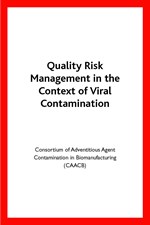Quality Risk Management in the Context of Viral Contamination (single user digital version)
- Format
- PDF Single user
- Member Price
- $55.00
- Nonmember Price
- $69.00
- Government Price
- $45.00
Please sign in or become a member to purchase items from the PDA bookstore.
Here are robust discussions of microbial identifications in a new light.
This reprint from Microbial Control and Identification: Strategies, Method and Applications edited by Dona Reber and Mary Griffin demonstrate how microbial identification knowledge is a cornerstone in the concept of microbial and contamination control programs.
The complete text contains more remarkably informative chapters. For details about content, a complete table of contents and ordering information please visit: go.pda.org/MCID
Available to download. Prior to purchase please view the download instructions and Terms of Usage
Format: PDF (1 file 2.83 MB)
Table of Contents
Table of Contents:
- Introduction
- Use of QRM Tools
- Initiation of Risk Management Process
- Risk Assessment
- Risk Control
- Result of Risk Management Process
- Risk Review
- References
About the Authors
About the Author
Consortium of Adventitious Agent Contamination in Biomanufacturing (CAACB) was formed in January of 2011 as an initiative at MIT's Center for Biomedical Innovation. As of publication, the CAACB consists of 24 member companies, including five associate members that provide services or technologies to support biopharmaceutical manufacturing but which do not themselves manufacture biologic products. The broad mission of the CAACB is to pool biomanufacturing expertise in the area of adventitious agent contamination. The consortium provides an avenue for discussion of adventitious agent contamination experience, risk of contamination, and methods to mitigate that risk. To enable this discussion, the CAACB conducts two main activities. First, it hosts workshops where specific topics related to the prevention and understanding of adventitious agent contamination are discussed in detail. Second, it conducts collaborative, precompetitive projects related to adventitious agent contamination and of interest to its members.

